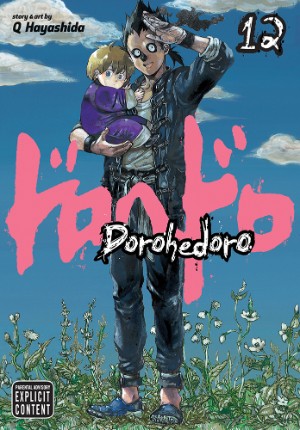By Q Hayashida. Released in Japan by Shogakukan, serialization ongoing in the magazine Ikki. Released in North America by Viz.
This volume of Dorohedoro is particularly good at showing off all the myriad reasons why it’s become one of the more addicting seinen manga out there. There are some amazingly violent fight scenes, some hysterical humor, a dose of complete insane weirdness, and some truly visceral horror – and not body horror this time around. I had wondered at first how long the series could keep its premise up, now I worry that with the series ending in Japan soon it won’t have time to tell me everything that I need to know.
Let’s start with the violence, which spirals out after En’s death. And En definitely appears to be dead this time, though there’s a suggestion they can reverse it if they find Judas’ Ear, who is missing. En’s people are somewhat gutted by this – even Noi, who notes that she hated En for forcing her into all of this, but still feels at a loss. As for Fujita, he’s absolutely devastated, having flashbacks and trauma from finding the body. Luckily, Shin knows that everything will be solved by finding the parties responsible and killing them. Finding the cross-eyes is the next step, and killing them mostly goes well, at least until the climax. Hayashida knows just how to choreograph fights, and also that her audience does not mind seeing splattered limbs.
Her audience also wants a healthy does of humor and weirdness, both of which dovetail nicely with the creation of a living En doll to try to lead them to the location of the real En, assuming he is alive. This involves baking a giant pizza, out of which the doll En them rises. If you can’t quite understand what I’m talking about, that’s because it makes no sense unless you see it. Any time Turkey appears things are odd, but this one takes the biscuit. We then get a very amusing chase scene, as the Doll En has a mind of its own and is not interested in letting Shin and Noi keep up with it. If you combine this with the ongoing humiliation of Natsuki (involving nudity this time, natch), we’ve got a lot of laughs in here.
But what I suspect folks will take away from this volume is the flashback that explains Nikaido’s past, who she’s so reluctant to do magic, and the horrors of time travel. Some lessons, particularly when you’re a child, need to be learned firsthand, and this is a particularly horrifying and bitter one for Nikaido, whose friend is lost forever thanks to her own folly about time magic. It contrasts with the cover art with Asu and a child Nikaido, with a blue sky and blooming flowers belie the serious contents within.
And so, in the end, we have something for everyone, a little bit of plot advancement, a lot of weird humor, and some terrifying existential terror. In other words, all the reasons to read Dorohedoro, encapsulated in one book. At least until the next volume, when I assume we’ll find more. We even see the gyoza fairy again!

